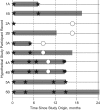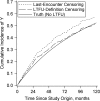When to Censor?
- PMID: 29020256
- PMCID: PMC6248498
- DOI: 10.1093/aje/kwx281
When to Censor?
Abstract
Loss to follow-up is an endemic feature of time-to-event analyses that precludes observation of the event of interest. To our knowledge, in typical cohort studies with encounters occurring at regular or irregular intervals, there is no consensus on how to handle person-time between participants' last study encounter and the point at which they meet a definition of loss to follow-up. We demonstrate, using simulation and an example, that when the event of interest is captured outside of a study encounter (e.g., in a registry), person-time should be censored when the study-defined criterion for loss to follow-up is met (e.g., 1 year after last encounter), rather than at the last study encounter. Conversely, when the event of interest must be measured within the context of a study encounter (e.g., a biomarker value), person-time should be censored at the last study encounter. An inappropriate censoring scheme has the potential to result in substantial bias that may not be easily corrected.
Figures



References
-
- Lau B, Gange SJ, Moore RD. Interval and clinical cohort studies: epidemiological issues. AIDS Res Hum Retroviruses. 2007;23(6):769–776. - PubMed
-
- Robins JM, Hernán MA, Brumback B. Marginal structural models and causal inference in epidemiology. Epidemiology. 2000;11(5):550–560. - PubMed
-
- Hernán MA, Robins J. Causal Inference. Boca Raton, FL: Chapman & Hall/CRC Press. In press.
-
- Robins JM, Finkelstein DM. Correcting for noncompliance and dependent censoring in an AIDS clinical trial with inverse probability of censoring weighted (IPCW) log-rank tests. Biometrics. 2000;56(3):779–788. - PubMed
Publication types
MeSH terms
Grants and funding
LinkOut - more resources
Full Text Sources
Other Literature Sources
Miscellaneous

